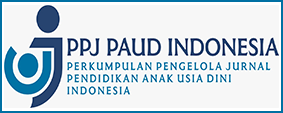
Author
Fadjri Kirana Anggarani(1
Psikologi, Universitas Sebelas Maret, Indonesia(1)
Psikologi, Universitas Sebelas Maret, Indonesia(2)
Psikologi, Universitas Sebelas Maret, Indonesia(3)
Psikologi, Universitas Sebelas Maret, Indonesia(4)
| Article Analytic |
Published : 2022-03-21
Article can trace at:
 Article Metrics
Article Metrics
Abstract Views: 647 times
PDF Downloaded: 413 times
Abstract
Pendidikan keuangan harus dimulai pada anak usia dini. Literasi keuangan bertujuan mempersiapkan siswa membuat keputusan keuangan yang akan dihadapi sebagai orang dewasa. Sayangnya, kebanyakan orang tua berpendapat bahwa anak-anak sebaiknya diajarkan mengelola uang atau yang dikenal sebagai literasi keuangan saat remaja. Penelitian ini bertujuan mengetahui pengaruh literasi keuangan dengan pendekatan bermain peran pada anak usia dini. Metode yang digunakan di dalam penelitian ini menggunakan pendekatan eksperimen kuasi dengan desain one group pretest-posttest. Studi melibatkan anak usia dini berjumlah empat puluh enam anak. Instrumen yang digunakan adalah media pendidikan literasi keuangan, pengukuran pengetahuan dan pengukuran situasi pembelajaran kelas. Hasil validasi Subject Matter Experts (SME) menunjukkan buku literasi keuangan yang digunakan memiliki konten yang sesuai dengan tujuannya. Uji pengaruh pada pengetahuan literasi keuangan dan lingkungan pembelajaran kelas adalah signifikan. Maka, dapat disimpulkan terdapat pengaruh pendidikan literasi keuangan dengan pendekatan bermain peran terhadap anak usia dini.
Keywords
References
Aiken, L. R. (1985). Three Coefficients For Analyzing The Reliability And Validity Of Ratings. Educational and Psychological Measurement, 45, 131-141.
https://doi.org/10.1177/0013164485451012
Ariyani, D. (2018). Pendidikan Literasi Keuangan pada Anak Usia Dini di TK Khalifah Purwokerto. Yinyang: Jurnal Studi Islam Gender Dan Anak, 13(2), 175-190. https://doi.org/10.24090/yinyang.v13i2.2100
Aulina, C. N. (2015). Pengaruh Bermain Peran Terhadap Kemampuan Sosial Anak Usia Dini. PEDAGOGIA: Jurnal Pendidikan, 4(1), 59. https://doi.org/10.21070/pedagogia.v4i1.73
Blair, C., & Razza, R. P. (2007). Relating effortful control, executive function, and false belief understanding to emerging math and literacy ability in kindergarten. Child Development, 78(2), 647-663. https://doi.org/10.1111/j.1467-8624.2007.01019.x
Blue, L. E., & Grootenboer, P. (2019). A praxis approach to financial literacy education. Journal of Curriculum Studies, 51(5), 755-770. https://doi.org/10.1080/00220272.2019.1650115
Campbell, D. T., & Stanley, J. C. (1984). Campbell and Stanley for Undergraduates. In Contemporary Psychology: A Journal of Reviews (Vol. 29, Issue 4). https://doi.org/10.1037/022808
Collins, J. M., & Odders-White, E. (2015). A framework for developing and testing financial capability education programs targeted to elementary schools. Journal of Economic Education, 46(1), 105-120. https://doi.org/10.1080/00220485.2014.976325
Cordero J. M., Gil M., P. F. (2016). The effect of financial literacy courses and their teachers on student achievement. Working Paper.
Fraser, B, J. (1998). Classroom environment instruments: development, validity and applications. Learning Environments Research, 1, 7-33.
Gold, L. A. (The P. C. of E. of O. U. (2016). Teachers' Perceptions Regarding Financial Literacy in Kindergarten Through Grade 2: Vol. August. The Patton College of Education.
Goldstein, T. (2015). Developing a Dramatic Pretend Play Game Intervention [author's name removed]. American Journal of Play, 10(3), 290-309.
Haryanti, P., Hidayati, A., Rodliyah, I., Nisful Laili, C., & Saraswati, S. (2020). Sosialisasi Literasi Keuangan Syariah Pada Anak Usia Dini. JIPEMAS: Jurnal Inovasi Hasil Pengabdian Masyarakat, 3(2), 136. https://doi.org/10.33474/jipemas.v3i2.6584
Howe, N. (1991). Generations The History of America's Future, 1584 to 2069 by by Neil Howe (Author), William Strauss (z-lib.
Kefela, G. (2011). Implications of financial literacy in developing countries. African Journal of Business Management, 5(9), 3699-3705.
Kemendikbud, T. G. (2017). Materi Pendukung Literasi Finansial. Gerakan Literasi Nasional, 1-41. http://gln.kemdikbud.go.id/glnsite/buku-literasi-finansial
Lillard, A., Pinkham, A. M., & Smith, E. (2011). Pretend play and cognitive development. In U. Goswami (Ed.), The Wiley-Blackwell handbook of childhood cognitive development (pp. 285-311). Wiley-Blackwell.https://doi.org/10.1002/9781444325485.ch11
Pal, I., von Meding, J., Shrestha, S., Ahmed, I., & Gajendran, T. (2017). Interdisciplinary Approach for Disaster Resilience and Sustainability. In Conference proceedings MRDRRE (p. 13).
Paulson, H. M. (2008). Taking Financial Literacy to the Next Level: Important Challenges and Promising Solutions. OECD-US Treasury International Conference on Financial Education, May.
Pujianti, T., Syaodih, E., & Djoehaeni, H. (2020). Peran Orang Tua Dalam Melakukan Financial Education Pada Anak Usia Dini. Edukid, 16(2), 99-108. https://doi.org/10.17509/edukid.v16i2.19796
Reynolds, A. J., & Candee, A. J. (2019). Dimensionality and Predictive validity of the Classroom Learning Activities Checklist in Prekindergarten Content courtesy of Springer Nature , terms of use apply . Rights reserved . Content courtesy of Springer Nature , terms of use apply . Rights reserve. 381-407. https://doi.org/10.1007/s11092-019-09306-7
Sabri, M. F., MacDonald, M., Hira, T. K., & Masud, J. (2010). Childhood consumer experience and the financial literacy of college students in Malaysia. Family and Consumer Sciences Research Journal, 38(4), 455-467. https://doi.org/10.1111/j.1552-3934.2010.00038.x
Saputro, J. S., Anggarani, F. K., & Anggrellangi, A. (2022). Desain Aplikasi "SAPA" Berbasis Computer-Mediated Communication (CMC) untuk Efektivitas Komunikasi Mahasiswa Tunarungu. Jurnal Basicedu Vol, 6(1). https://doi.org/10.31004/basicedu.v6i1.1931
Sherraden, M. S., Johnson, L., Guo, B., & Elliott, W. (2011). Financial Capability in Children: Effects of Participation in a School-Based Financial Education and Savings Program. Journal of Family and Economic Issues, 32(3), 385-399. https://doi.org/10.1007/s10834-010-9220-5
Slot, P. L., Mulder, H., Verhagen, J., & Leseman, P. P. M. (2017). Preschoolers' cognitive and emotional self-regulation in pretend play: Relations with executive functions and quality of play. Infant and Child Development, 26(6), 1-21. https://doi.org/10.1002/icd.2038
Sugiyono. (2018). Metode Penelitian Pendidikan Pendekatan Kuantitatif, Kualitatif, dan R&D. Alfabeta.
Suminar, D. R., & Hastjarjo, T. D. (2016). A Theoritical Model of Theory of Mind and Pretend Play. International Journal of Applied Psychology, 6(4), 85-93.
Suwanaphan, S. (2013). Personal Financial Literacy of Academic Support -. Management, Knowledge Amd Learning International Conference, 1061-1065.
Świecka, B. (2019). 1. A theoretical framework for financial literacy and financial education. Financial Literacy and Financial Education, March 2019, 1-12. https://doi.org/10.1515/9783110636956-001
Te'eni-Harari, T. (2016). Financial literacy among children: the role of involvement in saving money. Young Consumers, 17(2), 197-208. https://doi.org/10.1108/YC-01-2016-00579
Thelen, A. M. (2012). The impact of pretend play on cognitive and academic development of kindergarten students . https://scholarworks.uni.edu/grp/234
Refbacks
- There are currently no refbacks.

_2022_inPress.png)








